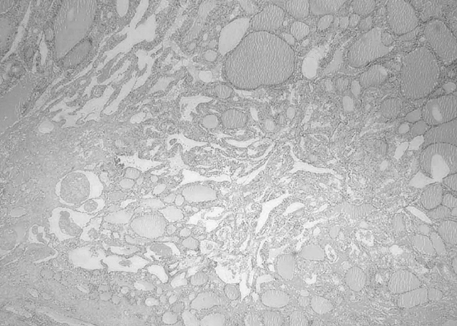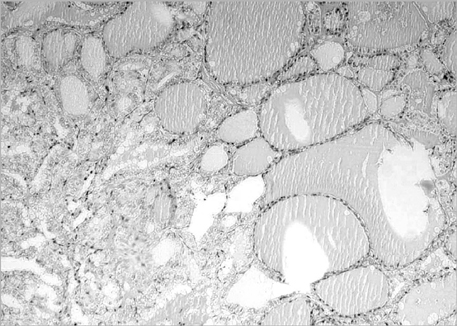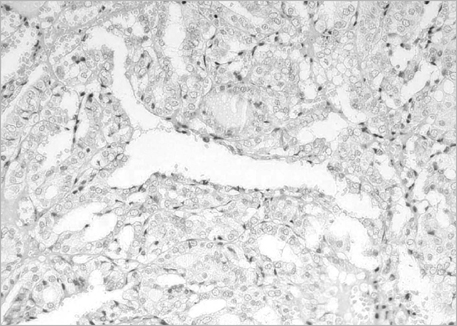J Korean Med Sci.
2010 Feb;25(2):327-329. 10.3346/jkms.2010.25.2.327.
Malignant Struma Ovarii: A Case Report
- Affiliations
-
- 1Department of Obstetrics and Gynecology, Kocaeli University, School of Medicine, Kocaeli, Turkey. gulserene@superonline.com
- 2Department of Pathology, Kocaeli University, School of Medicine, Kocaeli, Turkey.
- KMID: 1779271
- DOI: http://doi.org/10.3346/jkms.2010.25.2.327
Abstract
- We present a case of a 40-yr-old woman diagnosed with a primary malignant struma ovarii. The patient was admitted with the complaint of pelvic pain and a large pelvic mass in the mid-portion of lower abdomen on gynecological examination. Pre-operative tumor markers and routine biochemistry were unremarkable. She was treated with total abdominal hysterectomy and right salpingo-oopherectomy. Post-operatively, she was diagnosed with a malignant struma ovarii through the usage of histopathological criteria similar to the guidelines for primary thyroid gland disease. The patient was subsequently performed left salpingo-oopherectomy and retroperitoneal pelvic lympadenectomy for re-staging. Although, left ovary and lymph nodes were histopathologically normal, she was offered thyroidectomy but she refused to accept the offer. Thyroglobulin level was monitored in the post-operative period. She is free of the disease for 18 months.
Keyword
MeSH Terms
Figure
Reference
-
1. Berek JS, Hacker NF. Practical gynecologic oncology. 2003. 3rd ed. Philadelphia: Lippincott Williams & Wilkins;3–38.2. Serov SF, Scully RE, Sobin LH. Histological typing of ovarian tumors. International histological classification of tumors. No.9. 1973. Geneva: World Health Organization.3. Kabukcuoglu F, Baksu A, Yilmaz B, Aktumen A, Evren I. Malignant struma ovarii. Pathol Oncol Res. 2002. 8:145–147.
Article4. Rosenblum NG, LiVolsi VA, Edmonds PR, Mikuta JJ. Malignant struma ovarii. Gynecol Oncol. 1989. 32:224–227.
Article5. Zakhem A, Aftimos G, Kreidy R, Salem P. Malignant struma ovarii: report of two cases and selected review of the literature. J Surg Oncol. 1990. 43:61–65.
Article6. Volpi E, Ferrero A, Nasi PG, Sismondi P. Malignant struma ovarii: a case report of laparoscopic management. Gynecol Oncol. 2003. 90:191–194.
Article7. Dardik RB, Dardik M, Westra W, Montz FJ. Malignant struma ovarii; two case reports and review of the literature. Gynecol Oncol. 1999. 73:447–451.8. Gould SF, Lopez RL, Speers WC. Malignant struma ovarii. A case report and literature review. J Reprod Med. 1983. 28:415–419.9. Devaney K, Snyder R, Norris HJ, Tavassoli FA. Proliferative and histologically malignant struma ovarii: a clinicopathologic study of 54 cases. Int J Gynecol Pathol. 1993. 12:333–343.10. Chan SW, Farrell KE. Metastatic thyroid carcinoma in the presence of struma ovarii. Med J Aust. 2001. 175:373–374.
Article11. DeSimone CP, Lele SM, Modesitt SC. Malignant struma ovarii: a case report and analysis of cases reported in the literature with focus on survival and I131 therapy. Gynecol Oncol. 2003. 89:543–548.
Article12. Makani S, Kim W, Gaba AR. Struma ovarii with a focus of papillary thyroid cancer: a case report and review of the literature. Gynecol Oncol. 2004. 94:835–839.
Article13. Zekri JM, Manifold IH, Wadsley JC. Metastatic struma ovarii: late presentation, unusual features and multiple radioactive iodine treatments. Clin Oncol (R Coll Radiol). 2006. 18:768–772.
Article14. Balci TA, Kabasakal L. Is the I-131 whole-body scanning proper for follow-up management of patients with malignant struma ovarii without performing the thyroidectomy? Gynecol Oncol. 2005. 99:520.15. Roth LM, Karseladze AI. Highly differentiated follicular carcinoma arising from struma ovarii: a report of 3 cases, a review of the literature, and a reassessment of so-called peritoneal strumosis. Int J Gynecol Pathol. 2008. 27:213–222.
- Full Text Links
- Actions
-
Cited
- CITED
-
- Close
- Share
- Similar articles
-
- A Case of Malignant Struma Ovarii
- A Case Report: Malignant struma ovarii
- Malignant struma ovarii with hyperthyroidism ; radionuclide study and treatment
- MR Findings of Malignant Struma Ovarii Associated with Mature Cystic Teratoma of Contralateral Ovary: Case Report
- A Case of Primary Malignant struma ovarii Tumor of the Ovary




